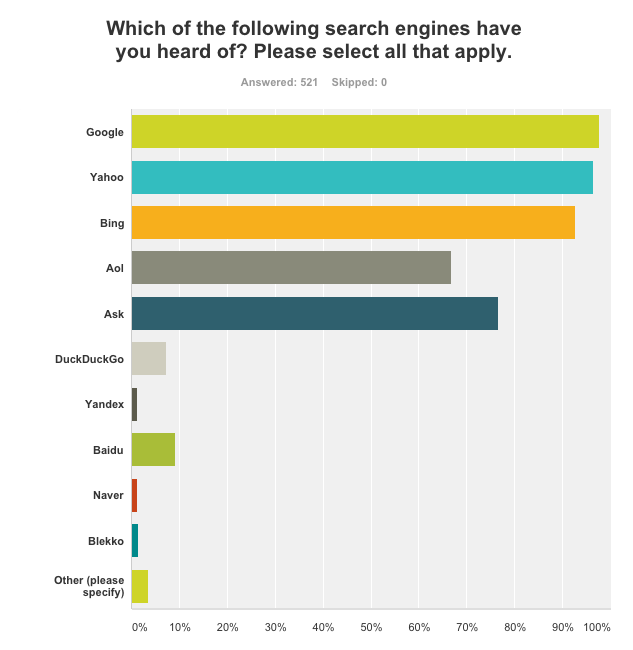The web-ranking tool SimilarWeb recently released their list of 2014’s 100 most visited websites in the US. Surprisingly, both Baidu, China’s largest search engine, and Yandex, Russia’s largest search engine, made it on the list. Baidu is listed at #22 which puts it ahead of many of the world’s most popular sites, including Imgur.com (24) Aol.com (25), and even Pinterest (29). Yandex barely made it in the top 100 with a 91 ranking, but it still tied with the popular video site Vimeo (91) and beat out Twitch.tv (100).

In no way does this achievement mean Yandex and Baidu are anywhere close to challenging Google’s dominance in the US, however, it is still quite monumental.
Search Engine Market Share
A few months back I conducted a survey using SurveyMonkey Audience (disclosure, I work for SurveyMonkey) of 521 Americans to understand the general awareness of the world’s popular search engines and which search engines have the most primary usage. From the survey data, only 9% of respondents had ever heard of Baidu and 1%, Yandex. To put some context around these numbers, 98% had heard of Google and 93%, Yahoo.
 Screenshot of survey 2/3/15
Screenshot of survey 2/3/15The survey also asked which search engines they have ever used. Only 1% of respondents had ever used Baidu or Yandex. When compared to Google and Bing, 98% and 76% had used these search engines respectively.
 Screenshot of survey 2/3/15
Screenshot of survey 2/3/15All users in the survey were chosen at random from SurveyMonkey Audience’s 4 million person respondent data set and the sample size was statistically significant for the entire US population. As a result, the sample should very closely mirror actual user behavior pretty closely and in fact this type of survey was even used to correctly predict election results in 2012, 2013, and 2014.
Why It Matters
While the SimilarWeb data does not mean Baidu or Yandex are making serious inroads into the search engine market in the US, here’s why the ranking data is still quite significant. The presence of foreign search engines on the list of top US websites means as you optimize your site for a US audience, you still need to take into account non-English customers in the US.
No longer can the modern SEO targeting in the US just focus on search engine best practices for Google and Bing. Your product might be targeted to a US-only audience, but you still need to think about to optimize for a non-English customer. And, it’s not just Yandex and Baidu. On SimilarWeb’s top 100 list there were a few non-US Google domains from the UK, India, Mexico, Pakistan, and South Africa. These are users in the US that choose to use a different Google ccTLD, and the rankings are different from those on Google.com.
A 1% market share each for Baidu and Yandex might not seem like a big number, but it still represents 6 million potential customers – more than the population of Chicago and Los Angeles combined. You wouldn’t ignore Chicago and Los Angeles in your marketing efforts, so why ignore the 6 million people who use Yandex or Baidu? Luckily, it’s not that difficult.
Think Global
Here are three quick ideas to make your American site just a little but more global:
- Research your keywords in non-English languages. If you sell Blue Widgets, you should at least know what the best way to say/write Blue Widgets in the most popular languages in the US. You may only be able to add your keyword in to a single paragraph on your site, but this beats not using the word at all.
- Create a handful of landing pages in other languages. This could be a big ask for your engineering team, but having a product page written in Spanish or French or whatever popular language you need could really help draw and sell to additional users.
- Add a Google Translate widget to your contact page, so if customers can’t find what they are looking for they at least figure out how to get in touch with you.
With just a little bit of effort you can expand your audience to anyone who might not be a fluent English speaker and you will increase your chances of being discovered on a non-English search in the US. As an added bonus, once you are ready to expand internationally you will already have a good foundation in place for how to make this happen.
Remember, if you don’t try to focus on this potential pool of customers, your competitors would be happy to reach them first.
How do you handle international website traffic?
Featured Image: Fredrik Alpstedt via Flickr





![[SEO, PPC & Attribution] Unlocking The Power Of Offline Marketing In A Digital World](https://www.searchenginejournal.com/wp-content/uploads/2025/03/sidebar1x-534.png)